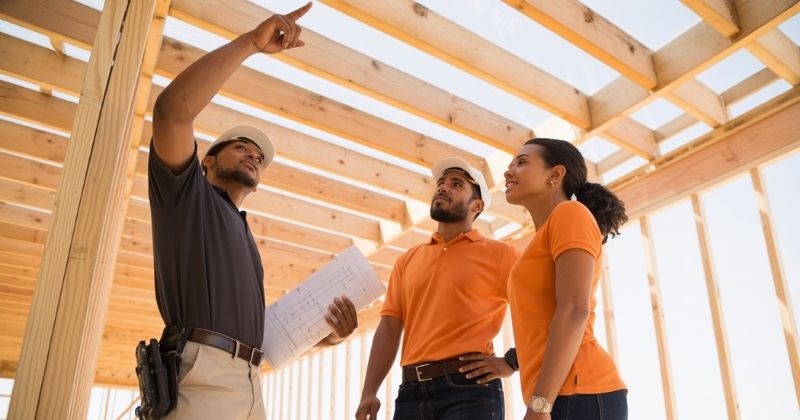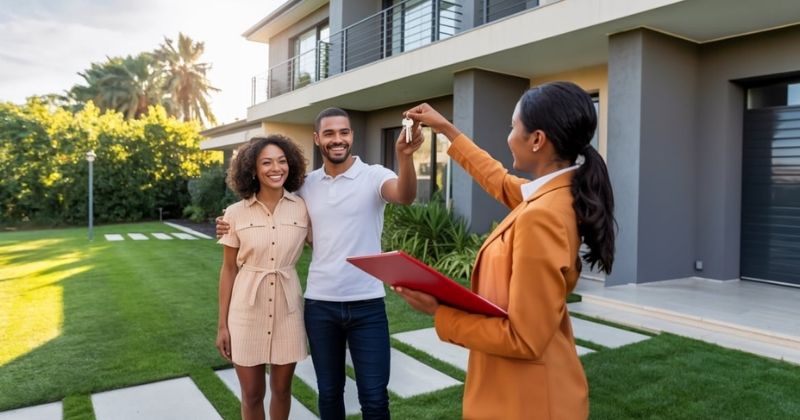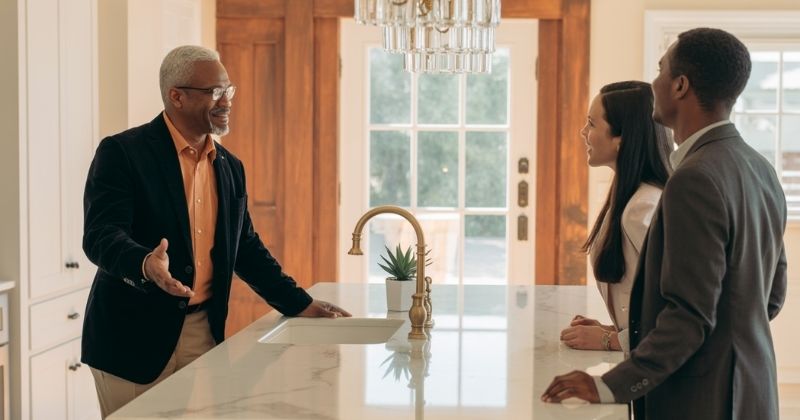
Deciding whether to build a house or purchase an existing one in South Africa is a personal matter, with each option offering distinct advantages depending on individual circumstances. While preferences and priorities will differ from person to person, the right choice depends on your financial situation, lifestyle needs, and future goals. For those still uncertain about which route to take, it is worth carefully considering whether it is more cost-effective to build or to buy, along with several other practical aspects that may have a significant impact on the overall decision.
Key Takeaways
- Building Offers Flexibility but Comes with Higher Costs: Constructing a home allows for personalisation and modern features, but it is generally 20% to 30% more expensive than buying and includes additional risks such as delays, hidden costs, and limited land sizes in new developments.
- Buying Provides Convenience and Predictability: Purchasing an existing home is often more budget-friendly, with clearer upfront costs, better access to infrastructure, and less administrative complexity, though older properties may require maintenance or upgrades.
- Financing Options Vary by Choice: Home loans for buying are more straightforward and usually cheaper than construction loans, which involve staged payouts and higher interest rates. Construction-to-permanent and bridging loans offer alternatives depending on your financial needs and timing.
About Arcadia Finance
Secure your loan with ease through Arcadia Finance. Pay no application fees and choose from 19 trusted lenders, all fully accredited by South Africa’s National Credit Regulator. Enjoy a simple, transparent process designed around your financial needs.
Building A New House
Advantages
- VAT is typically included in the selling price when purchasing a newly built home directly from a property developer, which means there is no need to pay separate transfer duty on top of the purchase amount.
- A building contractor who is registered with the National Home Builders Registration Council (NHBRC) must provide a five-year structural warranty along with a one-year warranty covering roof leaks.
- Homes within the same new development are often recently completed, which means they are still in good condition, modern in design, and generally well maintained, helping to support the potential growth in your property’s value.
- Buyers are typically allowed to customise the layout, finishes, and overall design of the home to suit personal preferences and current style trends.
- Ongoing maintenance costs tend to be minimal during the first few years of ownership, as all fixtures and fittings are newly installed.
Disadvantages
- Most newly developed housing projects and empty stands are found on the outskirts of cities or towns, which can raise concerns about security, access to public transport, and proximity to schools, shops, and medical facilities.
- While infrastructure may improve over time, future expansion of roads or the introduction of low-cost housing nearby could result in increased traffic noise, pollution, or even a negative impact on the resale value of your home.
- If adjacent plots have not yet been built on, it may be difficult to assess whether your future privacy will be affected once neighbouring homes are completed.
- There may be unexpected costs for land surveys, architectural plans, engineering work, or dealing with poor soil or unstable ground, all of which can increase the total budget significantly.
- It is possible to face uncertainty around the standard of construction or materials used, especially if the contractor has limited experience or a poor track record.
- Building projects often face delays which can make it difficult to plan your move-in date, potentially requiring temporary accommodation or causing overlap with current living arrangements.
- Plots in new developments tend to be smaller in comparison to properties in older, well-established areas, which may limit outdoor space and future extensions.
- Because stand sizes are relatively small, space for gardening, entertainment, or outbuildings may be limited.
- As the homeowner, you will likely need to regularly monitor progress on the construction site to ensure the end result aligns with your original vision, which can become stressful and demanding alongside your other responsibilities.
What Is the Average Cost to Build a House in South Africa?
Although buying an empty plot may initially seem more affordable than purchasing an already-built property, the significant expense lies in the construction itself. In South Africa’s major urban areas, the typical cost to build a standard suburban home generally falls between R10 000 and R15 000 per square metre. However, this figure can rise substantially, with costs reaching up to R25 000 per square metre for homes that feature premium materials and high-end finishes.
Whether you decide to customise from the ground up or snap up an existing gem, the path to ownership can be straightforward. Discover How to Become a Homeowner in South Africa to learn about budgeting, bond applications and everything in between.

Buying A House
Advantages
- From a safety and insurance perspective, buying in an established area often means there are fewer vacant stands surrounding the property, reducing potential security risks and possibly lowering insurance premiums.
- Well-developed neighbourhoods typically offer better infrastructure, including major roads, public transport, business hubs, schools, healthcare facilities, and shopping centres, making daily life more convenient.
- Property values in older suburbs are usually easier to assess, both in terms of current market trends and potential future growth, due to the area’s track record and existing comparable sales.
- Homes built in earlier decades often have more spacious layouts, with larger land parcels, more generous room sizes, and higher overall square meterage than what is offered by many newer developments.
- If there are concerns about the integrity of the building, professional assessments can be conducted to examine the structure for any signs of damage, poor workmanship, or substandard materials before committing to the purchase.
- Purchasing an older home at a fair price may offer good renovation potential, allowing the buyer to upgrade the look and feel of the home in a cost-effective manner while still benefiting from the larger structure.
Disadvantages
- If nearby properties have fallen into disrepair, this could negatively influence the resale value of your home, even if your property is well-maintained.
- Older homes are typically sold ‘voetstoots’, meaning the buyer accepts the property as-is, without any warranty for hidden or future defects.
- The existing layout, design, and finishes might not reflect your preferences, and changing them to suit your style or to keep up with modern standards could involve considerable cost.
- Some structural or maintenance issues might not be visible during viewings, and these hidden problems could result in unexpected repair work and significant expenses down the line.
How Much Does The Average House Cost?
If you have concluded that purchasing an existing home is the most suitable option for you, the next logical step is to understand what you are likely to pay. It is essential to remember that property prices vary based on a range of contributing factors, such as the specific location of the home, its condition, size, and the features it offers. Broader economic conditions and current housing market trends also influence the final selling price. Recent data suggests that the average price of a freehold property across South Africa is approximately R1 374 637, while the average cost of a sectional title unit stands at around R1 041 509.

Financing Options and Costs
Choosing whether to build or buy a home in South Africa involves understanding the different financing options available. Each loan type carries its own terms, costs, and level of complexity, which can significantly affect the total expense and suitability for your situation.
Standard Home Loans (Mortgages)
Standard home loans are typically used to finance the purchase of existing properties. The loan amount is paid out in full once approved, and repayment terms can extend up to 30 years. Interest rates are usually lower than those of construction loans, making monthly payments more manageable. A deposit of around 10% is commonly required, along with bond registration fees, transfer duty, and legal costs. Lenders will also assess your credit history and income before granting approval.
Building Loans (Construction Loans)
Building loans release funds in stages based on construction progress, with interest charged only on the amount disbursed. These loans often span 12 to 24 months and generally carry higher interest rates due to greater risk. Borrowers need to budget for additional costs such as architectural plans, land surveys, and compliance with NHBRC requirements. Deposits of 10% to 20% are typically required, and lenders may request detailed building plans before releasing funds.
Construction-to-Permanent Loans
Construction-to-permanent loans begin as building loans and convert into standard home loans once the house is completed. During construction, repayments are usually interest-only, transitioning to regular repayments after the loan converts. This option can reduce administrative costs and simplify the financing process but usually requires a higher upfront deposit and may start with elevated interest rates.
Bridging Loans
Bridging loans provide short-term funding, often used when waiting for the sale of an existing property or the finalisation of permanent finance. These loans come with high interest rates, shorter terms, and stricter conditions. They are designed to cover temporary cash flow gaps rather than serve as a long-term financing solution.

Which Choice is More Cost Effective?
Building a Home Has Higher Costs and Risks
Constructing a new home from the ground up is generally 20% to 30% more expensive than buying an existing property. The average cost per square metre for a typical freestanding house targeted at middle-income buyers is around R12 920. In addition to construction expenses, those building a home often need to budget for temporary accommodation during the process, which adds to the total outlay. Construction projects may also face setbacks, and it is wise to set aside an extra 20% to cover delays, breakages, and unforeseen cost increases. Despite these challenges, one advantage of building is the exemption from transfer duty, which can provide meaningful upfront savings.
Buying a Property Has Predictable Costs and Added Expenses
Purchasing an existing property involves different financial obligations, including bond registration, transfer costs, transfer duty, a deposit, and possibly repairs and insurance. While these costs vary depending on location and property type, buying generally allows the buyer to calculate the total cost with more accuracy, which supports better financial planning. This clarity makes buying more straightforward for budgeting purposes, especially for those who prefer knowing the full scope of their financial commitment early on.
Why Buying Is More Affordable For Now
Buying off-plan offers some of the same benefits as building, such as avoiding transfer duty, but the buyer still pays VAT, which is included in the purchase price. In most cases, this works out to be less tax than what is paid on existing homes. With slow house price growth in the current market, purchasing whether off-plan or a completed home, is widely considered the more cost-effective option at present. Factoring in all associated costs, buying remains the more economical choice for most South African buyers today.
Conclusion
Deciding whether to build or buy a home in South Africa depends largely on your financial position, time constraints, and personal preferences. Building a new house offers the benefit of customisation and modern features but involves higher upfront costs, potential delays, and greater involvement throughout the construction process. In contrast, buying an existing property is generally more cost-effective and provides quicker access to established infrastructure and amenities, although it may come with repair needs or design compromises. Buyers must also weigh financing options, tax implications, and long-term value when making their decision. Carefully comparing these factors, South African homebuyers can choose the route that aligns best with their goals and circumstances.
Frequently Asked Questions
Yes, on average, building a home is around 20% to 30% more expensive than buying an existing property. Costs for construction materials, labour, and professional services often push the overall budget higher, especially when accounting for delays or design upgrades.
No, transfer duty does not apply when building a home from scratch or buying directly from a developer where VAT is included in the price. However, if you buy an existing property, transfer duty will usually be payable based on the property’s value.
The average construction cost typically ranges from R10 000 to R15 000 per square metre, depending on location, materials, and design complexity. High-end finishes and premium locations can push costs up to R25 000 per square metre or more.
Yes, banks offer building loans that release funds in phases according to the progress of construction. These loans often require detailed building plans, higher deposits, and come with higher interest rates during the construction period.
Older homes are usually sold ‘voetstoots’, meaning they are purchased as-is without guarantees on hidden defects. Buyers should consider potential repair costs, outdated layouts, and the condition of plumbing, roofing, and electrical systems before making an offer.
Fast, uncomplicated, and trustworthy loan comparisons
At Arcadia Finance, you can compare loan offers from multiple lenders with no obligation and free of charge. Get a clear overview of your options and choose the best deal for you.
Fill out our form today to easily compare interest rates from 19 banks and find the right loan for you.


